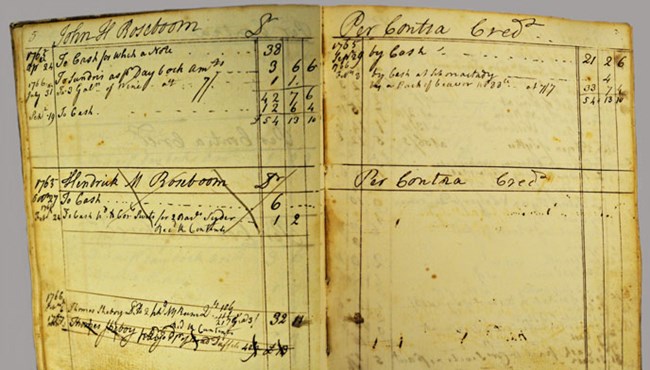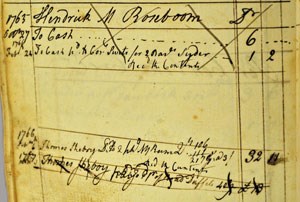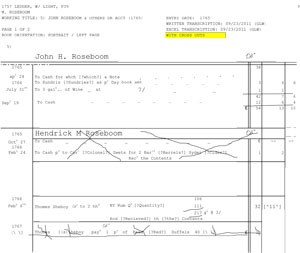
NPS image. John H. Roseboom
This two page entry details the debit and payoff of John H. Roseboom to Myndert Roseboom. The entries show the debits on the left page and credits on the right page. These transactions occurred at different times and are recorded to reflect ongoing business between John and Myndert during a two year period.
During the 18th century, the fur trade was booming and it is not uncommon to see beaver pelts traded and used as a form of currency. The final payment made by John occurred sometime after his final loan of cash on September 19, 1766. As detailed in the credit entry, a pack of beaver pelts weighing 88 lbs. were used to settle the remaining debt owed to Myndert in the sum of 33 pounds, 7 shilling, 4 pence.

NPS Image. Hendrick M. Roseboom
In the entries detailing the transactions between Hendrick M. Roseboom and Myndert Roseboom, the debits are described on the left page and the account is credited by crossing out the debt entries.
The transactions with Hendrick are also a bit more complicated. On February 24, 1766, Hendrick was given cash which was paid to Corporal Swets. This cash was meant to pay for 2 barrels of cider. Myndert received the contents of the barrels as payment for his loan of cash to Hendrick. This triangular payment was typical of the 18th century frontier economy.

NPS Image The large scale distilling of rum began in the colonies as early as 1708 (Purvis 1998: 98). Because the rum that was distilled in the colonies was not aged, it was deemed lower quality. The New York rum traded between Sheboy and the Roseboom's likely came from Albany given the Roseboom's strong ties to the city and the Quackenbush family who operated the Quackenbush Still House Rum distillery in Albany (Quackenbush 1909).

NPS Image Bookkeeping
Myndert calculated two separate numbers, 106 and 111, to get a total of 217 gallons of rum. If the rum was transported in these amounts, it would have been stored in a "hogshead" or barrel. The "hhd" detailed on this entry likely refers to hogshead sized barrels. Once arriving at its destination, the barrel could then be tapped and the rum distributed into bottles. During the 18th century rum was often added to water as a way to "purify" or kill harmful bacteria and was even included in daily rations for soldiers.
On February 6, 1766, Thomes Sheboy is again involved with trade between Hendrick and Myndert.Sheboy was paid on behalf of Hendrick Roseboom. Sheboy received 1 pair of red "duffels", or thick wool blankets, usually white with a red stripe on the end. The number "40" may refer to the size of the blankets. This transaction cancelled a debt that Hendrick owed to Myndert.
Further Questions
In 1767, military records from the New York State Museum indicate that Hendrick M. Roseboom was a Captain of the 1st Company Militia of Albany. Listed as "rank and file" under his command was Thomes Sheboy and John Roseboom (Hastings 1898: 802). It is unknown if the John Roseboom referred to on this page is the same John Roseboom serving in the militia under Hendrick Roseboom, but the coincidence is interesting to note.
The triangular payments recorded on this page allude to the complex trade relationships maintained by Myndert Roseboom. Upon further investigation the personal relationships between those named on this page become more animated but only further research will truly inform those complexities. For example, what power and influence did Hendrick exude over Thomes Sheboy in order to complete the triangular transactions that occurred with Myndert? By 1766 Myndert was also in the militia. What was the relationship between the three men outside of their military roles?
If Myndert is crediting the debts incurred by Hendrick by crossing them out, it seems that the debt for the rum was never resolved.
In regards to John H. Roseboom's transactions, the first recorded transaction on April 24, 1765 is a bit mysterious. What was the 'Note' for?
The debit entries for John and Hendrick are recorded differently and Myndert records their settling of accounts differently. One is detailed as a "contra" while the other debts are simply crossed out or canceled. Why did Myndert record these transactions differently?
Works Cited
Hastings, Hugh
1898 Third Annual Report of the State Historian of the State of New York 1897. Wynkoop Hallenbeck
Crawford Co.: New York.
McCusker, John J.
1989 Rum and the American Revolution: The Rum Trade and the Balance of Payments of the Thirteen Continental Colinies, Volumes 1 and 2. Garland Publishing: New York.
Purvis, Thomas L.
1999 Colonial America to 1763. Facts on File, Inc.: New York.
Quackenbush, Adriana Suydam
1909 Quackenbush Family in Holland and America. Quackenbush & Co.: Patterson, NJ.
Explore the Roseboom Ledgers John Fluno and John Dillebaugh Settlement with Major William Hogan |
Last updated: October 4, 2017
